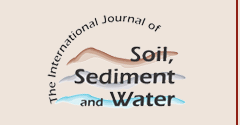Abstract
Mercury (Hg) and cyanide (CN-) are used as indicators of aquatic transport down gradient in ephemeral washes. The pattern of transport for Hg and CN- should mimic other metals (As, Cu, Cr, Pb, Ni, Ba) found in the soils. Hg and CN- were chosen to illustrate transport in surface soils because Hg and CN- are utilized in the milling process and Hg is available from the local geology. Stamp mills that utilize Hg and CN- flotation concentrate naturally occurring metals as byproducts. Soil samples collected from a wash system bisecting the mine waste site contained metal concentrations significantly above background levels. Mercury and cyanide concentrations showed dissimilar distribution patterns throughout the wash system with Hg and CN- 30- and 95- times greater than background concentrations. Concentrations of various heavy metals corresponded well with the concentrations of mercury and cyanide throughout the wash system validating the use of specific analytes as tracers of transport of contaminated soils.
Recommended Citation
Sims, Douglas Brian and Francis, Anthony
(2008)
"Mercury and Cyanide Used as Indicators of Sediment Transport in Ephemeral Washes at the Techatticup Mine and Mill Site, Nelson, Nevada (USA),"
International Journal of Soil, Sediment and Water: Vol. 1:
Iss.
2, Article 4.
Available at:
https://scholarworks.umass.edu/intljssw/vol1/iss2/4
